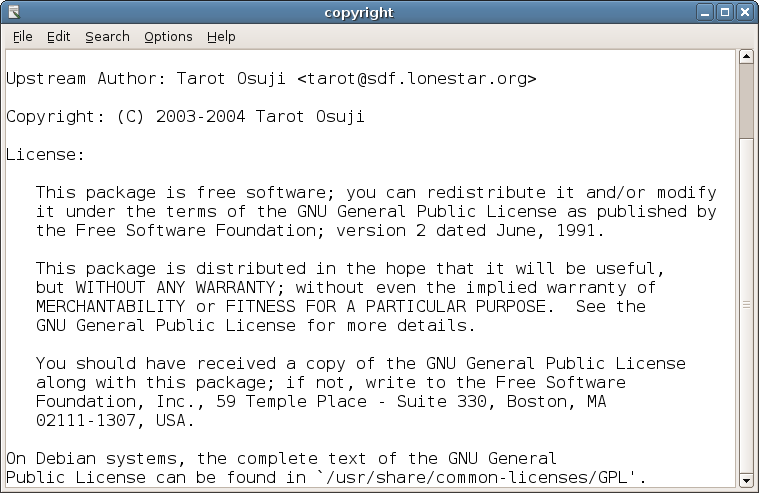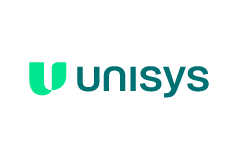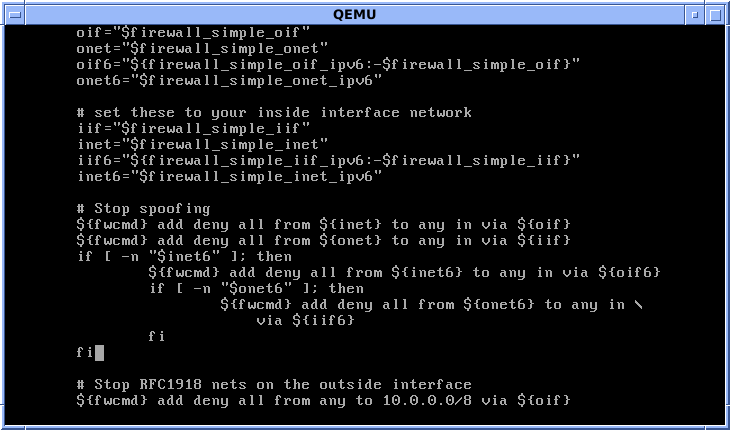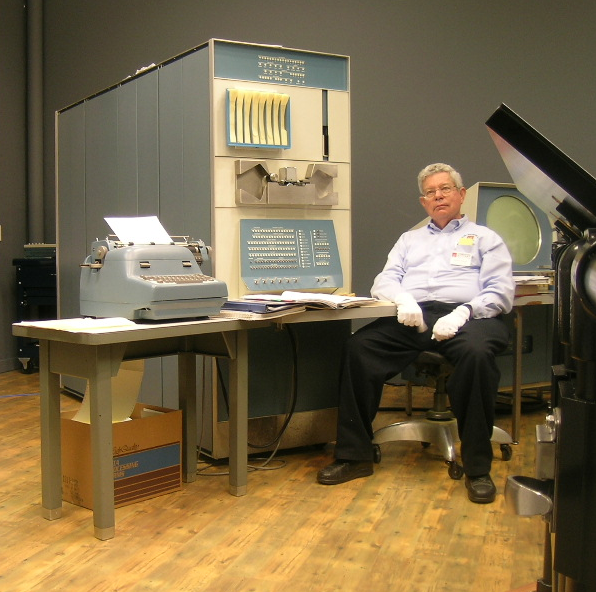|
Line Editor
In computing, a line editor is a text editor in which each editing command applies to one or more complete lines of text designated by the user. Line editors predate screen-based text editors and originated in an era when a computer operator typically interacted with a teleprinter (essentially a printer with a keyboard), with no video display, and no ability to move a cursor interactively within a document. Line editors were also a feature of many home computers, avoiding the need for a more memory-intensive full-screen editor. Line editors are limited to typewriter keyboard text-oriented input and output methods. Most edits are a line-at-a-time. Typing, editing, and document display do not occur simultaneously. Typically, typing does not enter text directly into the document. Instead, users modify the document text by entering these commands on a text-only terminal. Commands and text, and corresponding output from the editor, will scroll up from the bottom of the screen in the ... [...More Info...] [...Related Items...] OR: [Wikipedia] [Google] [Baidu] |
Text Editor
A text editor is a type of computer program that edits plain text. Such programs are sometimes known as "notepad" software (e.g. Windows Notepad). Text editors are provided with operating systems and software development packages, and can be used to change files such as configuration files, documentation files and programming language source code. Plain text and rich text There are important differences between plain text (created and edited by text editors) and rich text (such as that created by word processors or desktop publishing software). Plain text exclusively consists of character representation. Each character is represented by a fixed-length sequence of one, two, or four bytes, or as a variable-length sequence of one to four bytes, in accordance to specific character encoding conventions, such as ASCII, ISO/IEC 2022, Shift JIS, UTF-8, or UTF-16. These conventions define many printable characters, but also non-printing characters that control the flow of the ... [...More Info...] [...Related Items...] OR: [Wikipedia] [Google] [Baidu] |
Unisys
Unisys Corporation is an American multinational information technology (IT) services and consulting company headquartered in Blue Bell, Pennsylvania. It provides digital workplace solutions, cloud, applications, and infrastructure solutions, enterprise computing solutions, and business process solutions for organizations around the world. History Founding Unisys was formed in 1986 through the merger of mainframe corporations Sperry and Burroughs, with Burroughs buying Sperry for $4.8 billion. The name was chosen from over 31,000 submissions in an internal competition when Christian Machen submitted the word "Unisys" which was composed of parts of the words ''united'', ''information'' and ''systems''. The merger was the largest in the computer industry at the time and made Unisys the second largest computer company with annual revenue of $10.5 billion. Michael Blumenthal became CEO and Chairman. Soon after the merger, the market for proprietary mainframe-class systems—t ... [...More Info...] [...Related Items...] OR: [Wikipedia] [Google] [Baidu] |
Patch (Unix)
The computer tool patch is a Unix program that updates text files according to instructions contained in a separate file, called a ''patch file''. The patch file (also called a ''patch'' for short) is a text file that consists of a list of differences and is produced by running the related diff program with the original and updated file as arguments. Updating files with patch is often referred to as ''applying the patch'' or simply ''patching'' the files. History The original patch program was written by Larry Wall (who went on to create the Perl programming language) and posted to mod.sources (which later became comp.sources.unix) in May 1985. A variant of the program (but not the only one) is part of the GNU project and is maintained by the FSF. Usage context Developed by a programmer for other programmers, patch was frequently used for updating source code to a newer version. Because of this, many people came to associate patches with source code, whereas patches can in fact b ... [...More Info...] [...Related Items...] OR: [Wikipedia] [Google] [Baidu] |
Shell Script
A shell script is a computer program designed to be run by a Unix shell, a command-line interpreter. The various dialects of shell scripts are considered to be scripting languages. Typical operations performed by shell scripts include file manipulation, program execution, and printing text. A script which sets up the environment, runs the program, and does any necessary cleanup or logging, is called a wrapper. The term is also used more generally to mean the automated mode of running an operating system shell; each operating system uses a particular name for these functions including batch files (MSDos-Win95 stream, OS/2), command procedures (VMS), and shell scripts (Windows NT stream and third-party derivatives like 4NT—article is at cmd.exe), and mainframe operating systems are associated with a number of terms. Shells commonly present in Unix and Unix-like systems include the Korn shell, the Bourne shell, and GNU Bash. While a Unix operating system may have a different d ... [...More Info...] [...Related Items...] OR: [Wikipedia] [Google] [Baidu] |
IBM PC
The IBM Personal Computer (model 5150, commonly known as the IBM PC) is the first microcomputer released in the IBM PC model line and the basis for the IBM PC compatible de facto standard. Released on August 12, 1981, it was created by a team of engineers and designers directed by Don Estridge in Boca Raton, Florida. The machine was based on open architecture and third-party peripherals. Over time, expansion cards and software technology increased to support it. The PC had a substantial influence on the personal computer market. The specifications of the IBM PC became one of the most popular computer design standards in the world. The only significant competition it faced from a non-compatible platform throughout the 1980s was from the Apple Macintosh product line. The majority of modern personal computers are distant descendants of the IBM PC. History Prior to the 1980s, IBM had largely been known as a provider of business computer systems. As the 1980s opened, their ... [...More Info...] [...Related Items...] OR: [Wikipedia] [Google] [Baidu] |
Ex (text Editor)
ex, short for EXtended, is a line editor for Unix systems originally written by Bill Joy in 1976, beginning with an earlier program written by Charles Haley. Multiple implementations of the program exist; they are standardized by POSIX. History The original Unix editor, distributed with the Bell Labs versions of the operating system in the 1970s, was the rather user-unfriendly ed. George Coulouris of Queen Mary College, London, which had installed Unix in 1973, developed an improved version called em in 1975 that could take advantage of video terminals. While visiting Berkeley, Coulouris presented his program to Bill Joy, who modified it to be less demanding on the processor; Joy's version became ex and got included in the Berkeley Software Distribution. ex was eventually given a full-screen visual interface (adding to its command line oriented operation), thereby becoming the vi text editor. In recent times, ex is implemented as a personality of the vi program; most varian ... [...More Info...] [...Related Items...] OR: [Wikipedia] [Google] [Baidu] |
Ed (text Editor)
(pronounced as distinct letters, ) is a line editor for Unix and Unix-like operating systems. It was one of the first parts of the Unix operating system that was developed, in August 1969. It remains part of the POSIX and Open Group standards for Unix-based operating systems, alongside the more sophisticated full-screen editor vi. History and influence The ed text editor was one of the first three key elements of the Unix operating system—assembler, editor, and shell—developed by Ken Thompson in August 1969 on a PDP-7 at AT&T Bell Labs. Many features of ed came from the qed text editor developed at Thompson's alma mater University of California, Berkeley. Thompson was very familiar with qed, and had reimplemented it on the CTSS and Multics systems. Thompson's versions of qed were notable as the first to implement regular expressions. Regular expressions are also implemented in ed, though their implementation is considerably less general than that in qed. Dennis M. Ri ... [...More Info...] [...Related Items...] OR: [Wikipedia] [Google] [Baidu] |
Linux
Linux ( or ) is a family of open-source Unix-like operating systems based on the Linux kernel, an operating system kernel first released on September 17, 1991, by Linus Torvalds. Linux is typically packaged as a Linux distribution, which includes the kernel and supporting system software and libraries, many of which are provided by the GNU Project. Many Linux distributions use the word "Linux" in their name, but the Free Software Foundation uses the name "GNU/Linux" to emphasize the importance of GNU software, causing some controversy. Popular Linux distributions include Debian, Fedora Linux, and Ubuntu, the latter of which itself consists of many different distributions and modifications, including Lubuntu and Xubuntu. Commercial distributions include Red Hat Enterprise Linux and SUSE Linux Enterprise. Desktop Linux distributions include a windowing system such as X11 or Wayland, and a desktop environment such as GNOME or KDE Plasma. Distributions intended for ser ... [...More Info...] [...Related Items...] OR: [Wikipedia] [Google] [Baidu] |
PDP-1
The PDP-1 (''Programmed Data Processor-1'') is the first computer in Digital Equipment Corporation's PDP series and was first produced in 1959. It is famous for being the computer most important in the creation of hacker culture at Massachusetts Institute of Technology, BBN and elsewhere. The PDP-1 is the original hardware for playing history's first game on a minicomputer, Steve Russell's ''Spacewar!'' Description The PDP-1 uses an 18-bit word size and has 4096 words as standard main memory (equivalent to 9,216 eight-bit bytes, though the system actually divides an 18-bit word into six-bit characters), upgradable to 65,536 words. The magnetic-core memory's cycle time is 5.35 microseconds (corresponding roughly to a clock speed of 187 kilohertz); consequently most arithmetic instructions take 10.7 microseconds (93,458 operations per second) because they use two memory cycles: the first to fetch the instruction, the second to fetch or store the data word. Signed numbers are r ... [...More Info...] [...Related Items...] OR: [Wikipedia] [Google] [Baidu] |
Teleprinter
A teleprinter (teletypewriter, teletype or TTY) is an electromechanical device that can be used to send and receive typed messages through various communications channels, in both point-to-point and point-to-multipoint configurations. Initially they were used in telegraphy, which developed in the late 1830s and 1840s as the first use of electrical engineering, though teleprinters were not used for telegraphy until 1887 at the earliest. The machines were adapted to provide a user interface to early mainframe computers and minicomputers, sending typed data to the computer and printing the response. Some models could also be used to create punched tape for data storage (either from typed input or from data received from a remote source) and to read back such tape for local printing or transmission. Teleprinters could use a variety of different communication media. These included a simple pair of wires; dedicated non-switched telephone circuits (leased lines); switched network ... [...More Info...] [...Related Items...] OR: [Wikipedia] [Google] [Baidu] |
Digital Equipment Corporation
Digital Equipment Corporation (DEC ), using the trademark Digital, was a major American company in the computer industry from the 1960s to the 1990s. The company was co-founded by Ken Olsen and Harlan Anderson in 1957. Olsen was president until forced to resign in 1992, after the company had gone into precipitous decline. The company produced many different product lines over its history. It is best known for the work in the minicomputer market starting in the mid-1960s. The company produced a series of machines known as the PDP line, with the PDP-8 and PDP-11 being among the most successful minis in history. Their success was only surpassed by another DEC product, the late-1970s VAX "supermini" systems that were designed to replace the PDP-11. Although a number of competitors had successfully competed with Digital through the 1970s, the VAX cemented the company's place as a leading vendor in the computer space. As microcomputers improved in the late 1980s, especially wit ... [...More Info...] [...Related Items...] OR: [Wikipedia] [Google] [Baidu] |





.jpg)

